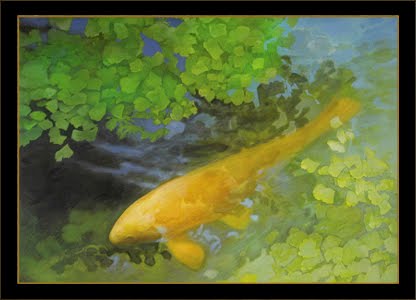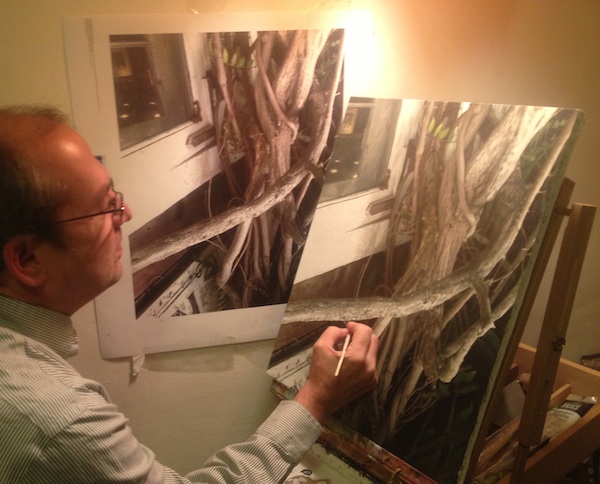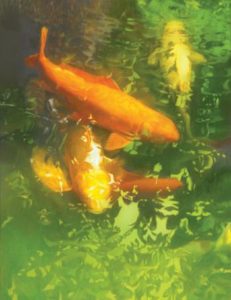Each painting creates its own special set of problems, because each one is its own lesson in itself. As you are painting, you are going to discover things along the way that will alter your original approach.

- Are you squinting a lot when you are viewing your unfinished painting?
- Leaning your head to one side, hoping that this will make it all look better?
- At a loss as to what your next moves are going to be?
- Like a punch drunk boxer, are you just jabbing away with your paint brush just hoping something good will happen?
- Are you painting the same areas over continually and things are still not making sense?
- Is your painting turning into that work of art that you had originally envisioned? Or is it just “so-so”?
These could be a signals that your painting is not going along as planned. Your battle plan may have to change. And it always is a battle isn’t it? A battle inside your brain.
When they refer to modern combat these days, they usually refer to an “ever-changing” strategy to meet the continually adapting tactics of the enemy. I like to apply this principle when it comes painting. I want to always be open to change as the process goes along.
This method will make you start to reevaluate your original approach and that is the most important thing.
Turning your head to the side when you examine your work may be a non-verbal message to yourself telling you to just rotate the darn thing.
Just take the whole painting and your reference sketches and flip them both upside down!

Think of it as a possible exit strategy to your present dilemma. I just would not be able to finish a painting if I didn’t turn it upside down. I do it all the time. To me there are just not enough visual hints there right side up to make me figure it all out, no pun intended, I just never see the whole picture.
Obvious compositional problems right in front of me are always eluding me because I am only studying everything from a single perspective.
This little ditty usually pops in my head, with my deepest apologies to Devo: “When a problem comes along, you must flip it.”
Turning your paintings upside down does have its advantages:
1. It will force you to perceive the composition in a different way. You are naturally going to pick up on new things when you have to refocus and the more visual hints there for you the better. This
exercise will push you to update your out-of-date plan of action, even though this means that you are going to have to do a lot more thinking than you had originally intended. But that is always the case isn’t it?
2. You are most likely going to find a lot more mistakes that would of never occurred to you. Now in the long run, this is a pretty good
thing because you know where the problems are, the bad news is that you will have a long list of things that need to be fixed. But at least you are formulating solutions to the problem
3. You get to approach the painting with brushstrokes from different angles. This can breath new life into a work that has been turning into a real chore for you. I am most comfortable with a brush stroke that goes from left to right so by turning it upside down I am able to take advantage of brush strokes that I might feel more confident with.
4. You will have a better understanding of how all the elements work together. It will increase your awareness as how your composition fits together as a whole. You might suddenly realize that the area in your painting that you are most proud of is the thing that is throwing the monkey wrench in your best your plans. Happens all the time. It wakes you up out of your stupor.
It is healthy breaking out of old routines.
5. It goads you out of your comfort zone. It may help push you to greater heights as an artist by waking up your survival skills. This may be the thing that renews your excitement in your painting. Also, why go down the same road? Why not cover new ground?
As artists don’t we always want to be improving? It may help you find the one crucial element that would tie everything together. How cool would that be?
It will give you better access to those hard to get to places that may need your attention. You have to face these trouble areas sometime and now would be the time to take care of them. That may be the whole ballgame right there.
When you are satisfied with the what you have painted upside down, turn it back right side up to examine your progress. Hopefully you will have a tighter composition and you will have got a better grasp of how the all elements in your painting are working together.
Guest artist/author: Robert J. Conway has a Bachelor of Fine Arts Degree from the State University of New York at New Paltz. He is currently working as an Art Director working at Bliss in New York’s Soho. He resides with his wife Connie and son Griffin in Glen Rock, New Jersey.
*****
Thank you Robert, for sharing a very insightful post. I often turn my paintings upside down and I also use a mirror. This is a great tip!
***Let’s talk about art on Twitter, and on my Fine Art Tips Facebook Fan Page Google Plus, Pinterest! Please checkout my art too LoriMcNee.com, or find me on Instagram lorimcneeartist
.








Sometimes one has to turn the canvas upside down to paint at the right angle! Photo: http://ow.ly/cNuFM
True Charles. It especially helps me when painting still life.
I agree! I even paint upside down regularly as it switches my left brain off and let’s the creative right brain take charge!
Me too Alison! It’s such an easy way to get a new perspective…
Cheers,
Lori
so great , thanks so much to let us know so much about the paintings . learn much more
Happy to hear this helped you! Thanks so much 🙂
Great post! I discovered how beneficial turning my painting over was by accident. I turned my painting to allow the bottom edge to dry and noted things I hadn’t seen before. Now I turn my paintings regularly. Thanks for sharing your expertise.
Isn’t amazing how much we learn from our accidents? Glad you enjoyed this post 🙂
Nice to see more articles about upside-down art.
Today we are finding artists everywhere mimicking the topsy-turvy style of American Artist L. R. Emerson II who started an international movement involving upside-down, multi-directional art. Emerson is credited with inventing Upside-Down Art.
Please visit http://www.upside-down-art.com to see the fantastic work of internationally known American artist L. R. Emerson II. Emerson is the leading artist of the Upside-Down Art movement having created and shared thirty years of artmaking success and documented invention regarding multi-directional design and compositional arrangement. Due to Emerson’s published research and exploration Art Education texts are having to be re-written to include Emerson’s compositional variant; upside-down, multi-directional composition has been validated and stands alone as a worthy from of composing subjects.
Emerson’s work has been presented to more than 500 galleries in the U.S.A. and to over 50 major museums across the planet.
His pioneering effort, enduring over three decades to break the glass ceiling of conventional composition sets L. R. Emerson II apart from followers of the Upside-Down movement.
L. R. Emerson II may very well be the Thomas Edison of artmaking. More information documenting Emerson’s thirty-five unique methods for creating upside down art can be found in the book The Purple Tree; Art in a Boundless Age, 2009
Mary Arkin
Hello Mary, I really enjoyed your comment and think this would be a great blog post idea. Would you be interested in sharing one about Emerson and the Upside-Down Art movement? Let me know what you think… ~Lori
Lori;
This makes so much sence to me when I tried to turn the original photo upside down.
The item seems so much easier to grasp…it does really ‘Decode’ it self in a way ????
Thanks for sharing!
Hello Siv, thanks for your comment a long time ago! I am way behind, but want you to know I appreciate you!